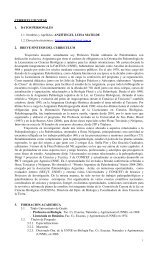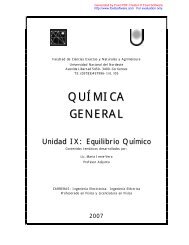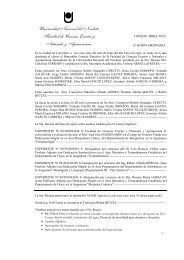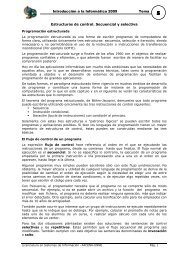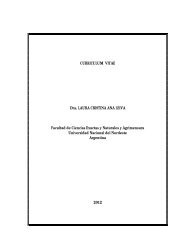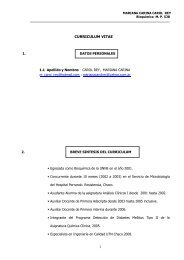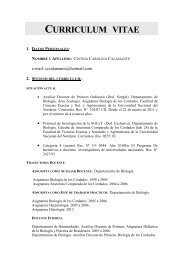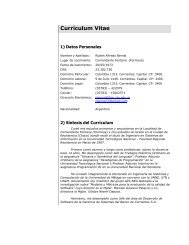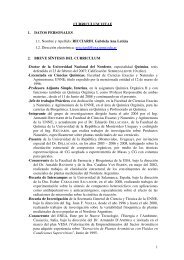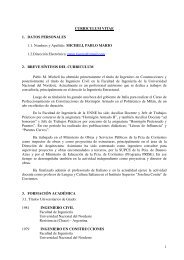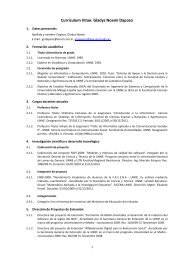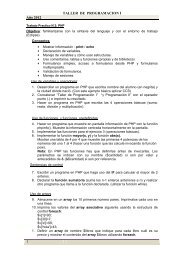Formation and function of the lytic NK‑cell immunological synapse
Formation and function of the lytic NK‑cell immunological synapse
Formation and function of the lytic NK‑cell immunological synapse
- No tags were found...
You also want an ePaper? Increase the reach of your titles
YUMPU automatically turns print PDFs into web optimized ePapers that Google loves.
REVIEWSBox 3 | The inhibitory <strong>immunological</strong> <strong>synapse</strong> in NK cellsLipid raftsLiquid-ordered membranedomains that are enriched insphingolipids <strong>and</strong> cholesterol,<strong>and</strong> also contain glycophosphatidylinositol-anchoredreceptors. They can provideordered structure to <strong>the</strong> lipidbilayer <strong>and</strong> have <strong>the</strong> ability toinclude or exclude specificsignalling molecules <strong>and</strong>complexes. Given that mosttechniques for studying lipidrafts are indirect (such ascell-membrane binding <strong>of</strong>cholera toxin, cholesterolsequestration using nonspecificreagents <strong>and</strong> cell fractionationbased on detergent sensitivity),<strong>the</strong>ir physiological relevance<strong>and</strong> <strong>function</strong> remaincontroversial.Microtubule‐organizingcentre(MTOC). A structure that isfound in all plant <strong>and</strong> animalcells from which microtubulesradiate. The two mostimportant types <strong>of</strong> MTOC are<strong>the</strong> basal bodies that areassociated with cilia, <strong>and</strong><strong>the</strong> centrosome, which iscomposed <strong>of</strong> γ-tubulin-ringcomplexes for microtubulenucleation.An important structure besides <strong>the</strong> <strong>lytic</strong> <strong>synapse</strong> that can form between a natural killer (NK) cell <strong>and</strong> ano<strong>the</strong>r cell is <strong>the</strong>inhibitory <strong>synapse</strong> 17 . Because resting NK cells contain <strong>lytic</strong> granules <strong>and</strong> express germline-encoded activating receptors,a robust mechanism for restraining <strong>the</strong> formation <strong>of</strong> a <strong>lytic</strong> <strong>synapse</strong> is essential to avoid inadvertent cytolysis. NK cellsexpress a family <strong>of</strong> inhibitory receptors that recognize determinants <strong>of</strong> self <strong>and</strong> prevent <strong>the</strong> lysis <strong>of</strong> healthy cells. Thisinhibitory activity is mediated through <strong>the</strong> formation <strong>of</strong> an inhibitory <strong>synapse</strong>. Here, inhibitory receptors such as <strong>the</strong>killer-cell immunoglobulin-like receptors (KIRs), which contain long cytoplasmic tails with immunoreceptor tyrosine-basedinhibitory motifs, engage <strong>the</strong>ir lig<strong>and</strong>s <strong>and</strong> induce <strong>the</strong> activity <strong>of</strong> phosphatases such as SHP1 (SRC-homology-2-domaincontainingprotein tyrosine phosphatase 1) 40,131 . The clustering <strong>of</strong> KIRs <strong>and</strong> associated components at <strong>the</strong> inhibitory <strong>synapse</strong>has been termed <strong>the</strong> supramolecular inhibitory cluster (SMIC) 17 (see figure). The SMIC is distinguished from <strong>the</strong> NK-cellsupramolecular activation cluster (SMAC) in that it excludes lipid raft membrane domains 37,132–134 , does not accumulatesubstantial filamentous actin (F-actin) 31 <strong>and</strong> contains inhibitory signalling molecules such as SHP1 (REFs 10,18,131,134).The <strong>function</strong> <strong>of</strong> <strong>the</strong> SMIC in preventing SMAC formation is achieved by preventing actin reorganization 22,23 , blocking <strong>the</strong>recruitment <strong>of</strong> activatingreceptors 24,135 <strong>and</strong> promotingdetachment from <strong>the</strong> targetcell 72 . Mechanistically, thisis probably due to <strong>the</strong>dephosphorylation <strong>of</strong> keymolecules involved in F-actindynamics, including VAV1(REFs 23,136) <strong>and</strong> ezrinradixin-moesinproteins 23 . As aresult, <strong>the</strong> NK-cell <strong>synapse</strong> isprobably a key site for signalintegration between inhibitory<strong>and</strong> activating receptors 11 .The three-dimensionalorganization <strong>of</strong> <strong>the</strong> SMIC hasbeen described to include anearly recruitment <strong>of</strong> KIRs to <strong>the</strong>centre <strong>of</strong> <strong>the</strong> SMIC, which <strong>the</strong>nmigrate to <strong>the</strong> periphery <strong>of</strong><strong>the</strong> <strong>synapse</strong>, although severalmolecular patterns for <strong>the</strong>SMIC have been reported 10,17,18 .MTOC, microtubule-organizingcentre.SMICKIR2DL1 + NK cellF-actinKIR2DL1MTOCMicrotubuleSMACKIR2DL1 + NK cellKIR2DL1The events that occur at <strong>the</strong> same time as actin reorganizationhave not yet been fully elucidated, but <strong>the</strong>yinclude receptor clustering, lipid-raft aggregation, fur<strong>the</strong>ractivation signalling <strong>and</strong> <strong>lytic</strong>-granule redistribution.Although many receptors might be present in <strong>the</strong> <strong>synapse</strong>at <strong>the</strong> initial stages, some accumulate rapidly after cellconjugation, <strong>and</strong> <strong>the</strong>se include those that are importantin both cell adhesion <strong>and</strong> triggering <strong>of</strong> cytotoxicity. Of<strong>the</strong>se, CD11a, CD11b <strong>and</strong> CD2 do not seem to clusterin <strong>the</strong> absence <strong>of</strong> actin reorganization 12 , <strong>the</strong>reby providingsome evidence for linearity in <strong>synapse</strong> formation.The mechanisms underlying actin-dependent receptorclustering in NK cells are not clear, but <strong>the</strong> ezrin, radixin<strong>and</strong> moesin (eRM) family <strong>of</strong> proteins are present in <strong>the</strong>NK-cell <strong>lytic</strong> <strong>synapse</strong> 23,30,31 <strong>and</strong> are known to <strong>function</strong> inlateral receptor motility in o<strong>the</strong>r cell types 32–35 .A related issue is that <strong>of</strong> lipid rafts. whe<strong>the</strong>r <strong>the</strong>se membranedomains represent discrete entities or more fluidcollections <strong>of</strong> molecules is unclear, but <strong>the</strong>y have beenshown to aggregate at <strong>the</strong> NK-cell <strong>lytic</strong> <strong>synapse</strong> (reviewedin REF. 36) <strong>and</strong> <strong>the</strong>ir integrity is probably required for cytotoxicity,as shown in experiments using <strong>the</strong> nonspecificcholesterol-sequestering reagent β-methylcyclodextrin 37 .The existence <strong>and</strong> <strong>function</strong> <strong>of</strong> lipid rafts, unfortunately,HLA-Cw4HLA-Cw4 + target cellHLA-Cw3 + target cellHLA-Cw3Activating lig<strong>and</strong>–receptor pairsor adhesion molecules• KIR2DL1 clusters at NK-cell SMIC• HLA-Cw4 (cognate KIR2DL1 lig<strong>and</strong>)accumulates in target cell• F-actin does not accumulate atNK-cell SMIC• MTOC does not polarize• Nei<strong>the</strong>r KIR2DL1 nor HLA-Cw3(non-cognate lig<strong>and</strong>) cluster at<strong>the</strong> SMAC• F-actin accumulates at <strong>the</strong> NK-cellSMAC• MTOC polarizes to <strong>the</strong> SMAChave been defined using indirect Nature methods, Reviews such | Immunology as choleratoxin binding to <strong>the</strong> cell membrane, detergent-resistantbiochemical fractionation <strong>and</strong> cholesterol sequestration,<strong>and</strong> <strong>the</strong>refore remain controversial. Similar to receptorclustering, however, lipid-raft aggregation at <strong>the</strong> NK-cell<strong>synapse</strong> depends on actin polymerization 23 , which fur<strong>the</strong>rsupports a linear progression through <strong>the</strong> early effectorsteps <strong>of</strong> <strong>synapse</strong> formation.It has been shown that receptor clustering at <strong>the</strong>NK-cell <strong>lytic</strong> <strong>synapse</strong> is important for <strong>the</strong> induction <strong>of</strong>robust signalling in NK cells 38 . In T cells, TCR signallingstems from microclusters <strong>of</strong> TCR molecules thatmove from <strong>the</strong> pSMAC to <strong>the</strong> cSMAC as activationproceeds 39 . Although <strong>function</strong>al microclusters havebeen identified in NK cells, <strong>the</strong>se have only been investigatedat <strong>the</strong> supramolecular inhibitory cluster 40 . So, itis unclear whe<strong>the</strong>r <strong>the</strong> level <strong>of</strong> signalling organization <strong>of</strong><strong>the</strong> pSMAC <strong>and</strong> cSMAC that is observed in T cells canbe similarly applied to <strong>the</strong> NK-cell <strong>lytic</strong> <strong>synapse</strong>.Ano<strong>the</strong>r requirement for effector <strong>function</strong> <strong>of</strong> <strong>the</strong>NK-cell <strong>lytic</strong> <strong>synapse</strong> is <strong>the</strong> polarization <strong>of</strong> <strong>lytic</strong> granulesto <strong>the</strong> <strong>synapse</strong>. This begins with movement <strong>of</strong><strong>the</strong> granules along microtubules to <strong>the</strong> microtubuleorganizingcentre (MTOC). Owing to <strong>the</strong> minus ends <strong>of</strong>718 | SePTeMbeR 2008 | vOLuMe 8 www.nature.com/reviews/immunol
REVIEWSVesicle primingThe process <strong>of</strong> preparing,through <strong>the</strong> acquisition <strong>of</strong>biochemical attributes,a secretory vesicle (such as a<strong>lytic</strong> granule) for fusion with <strong>the</strong>inner leaflet <strong>of</strong> <strong>the</strong> membrane.microtubules being present at <strong>the</strong> MTOC, <strong>lytic</strong> granulesrequire a minus-ended-directed motor, such as dynein,to move along microtubules. The exact motor used,however, has not been defined. while <strong>lytic</strong> granulesaggregate around <strong>the</strong> MTOC, <strong>the</strong> MTOC also beginsto polarize towards <strong>the</strong> <strong>immunological</strong> <strong>synapse</strong>. Signalsthat are required for MTOC polarization include eRK(extracellular-signal-regulated kinase) phosphorylation,vAv1 activation <strong>and</strong> PYK2 (protein tyrosine kinase 2)activity in NK cells 26,41,42 . In T cells, MTOC polarizationalso requires CDC42 (cell-division cycle 42) 43 <strong>and</strong>activation <strong>of</strong> a signalling platform comprising ZAP70(ζ-chain-associated protein kinase <strong>of</strong> 70 kDa), SLP76(SRC-homology-2-domain-containing leukocyte protein<strong>of</strong> 76 kDa) <strong>and</strong> LAT (linker for activation <strong>of</strong> T cells) 44 , aswell as <strong>the</strong> <strong>function</strong> <strong>of</strong> <strong>the</strong> formins Diaphanous-1 <strong>and</strong>Formin-like-1 (REF. 45). The molecular motors used for<strong>the</strong> propulsion or <strong>the</strong> force-generating steps that arerequired to pull <strong>the</strong> MTOC to <strong>the</strong> NK-cell <strong>synapse</strong> havenot been defined. CDC42-interacting protein 4 (CIP4;also known as TRIP10), which interacts with tubulin,CDC42 <strong>and</strong> wASP, localizes to <strong>the</strong> MTOC after <strong>synapse</strong>formation <strong>and</strong> is required for complete MTOC polarization46 . unlike CDC42 in T cells 42 or vAv1 in NK cells 26 ,however, reducing CIP4 <strong>function</strong> does not impair actinreorganization in NK cells 46 . Although <strong>the</strong> mechanismunderlying CIP4 <strong>function</strong> is not known, it might activelyparticipate in MTOC motility or it might help to anchor<strong>the</strong> MTOC to <strong>the</strong> NK-cell <strong>synapse</strong> by interacting withwASP or CDC42. Polarization <strong>of</strong> <strong>the</strong> MTOC in NK cellsalso probably depends on <strong>the</strong> appropriate insertion <strong>of</strong> <strong>the</strong>plus ends <strong>of</strong> microtubules into <strong>the</strong> accumulated F-actinat <strong>the</strong> <strong>synapse</strong>, which in T cells has been shown to bemediated through ADAP (adhesion- <strong>and</strong> degranulationpromotingadaptor protein) 48 <strong>and</strong> could <strong>function</strong> toapply force to <strong>the</strong> MTOC as <strong>the</strong> <strong>synapse</strong> reorganizes.In NK cells, <strong>the</strong> integrity <strong>and</strong> reorganization <strong>of</strong> <strong>the</strong>F-actin network is required for MTOC <strong>and</strong> <strong>lytic</strong>-granulepolarization to <strong>the</strong> <strong>synapse</strong>, as blockade <strong>of</strong> actin <strong>function</strong>prevents such polarization 2,12,26 , <strong>the</strong>reby fur<strong>the</strong>r defininga linear series <strong>of</strong> events in <strong>synapse</strong> formation.Requirements for cytokine secretion at <strong>the</strong> <strong>synapse</strong>are less well established but have been shown to requirewASP in T cells 49 <strong>and</strong> can occur in both a directed <strong>and</strong>multidirectional manner 50 . However, <strong>the</strong>re are severalimportant differences between <strong>the</strong> cellular mechanismsunderlying secretion <strong>of</strong> cytokines <strong>and</strong> <strong>lytic</strong>-granule contents,<strong>and</strong> <strong>the</strong> ability to separate <strong>the</strong> two events is probablycrucial for achieving specificity in immune responses.Although actin <strong>function</strong> is required for MTOC<strong>and</strong> <strong>lytic</strong>-granule polarization, a discrete region <strong>of</strong> <strong>the</strong>F-actin network needs to be disassembled to create aconduit through which <strong>the</strong> granules gain access to <strong>the</strong>plasma membrane. The <strong>function</strong> <strong>of</strong> <strong>the</strong>se conduitsremains hypo<strong>the</strong>tical, however, large channels <strong>of</strong> 1–4 µmin diameter are <strong>of</strong>ten observed in <strong>the</strong> cSMAC <strong>of</strong> a prototypicalNK-cell <strong>lytic</strong> <strong>synapse</strong> 12,18,51,52 . Theoretically,<strong>the</strong>se conduits could also be smaller channels that arejust large enough to allow <strong>the</strong> transit <strong>of</strong> <strong>the</strong> ~500 nmdiameter <strong>lytic</strong> granules. The mechanism responsiblefor this targeted F-actin disassembly is unknown, but itseems to be independent <strong>of</strong> MTOC polarization, as actinclearance occurs normally in NK cells that are treatedwith microtubule depolymerizing agents 12 . So, this stepoccurs before MTOC polarization in <strong>the</strong> sequence thatleads to <strong>synapse</strong> maturation.Following MTOC polarization at <strong>the</strong> <strong>synapse</strong>, <strong>the</strong>reare several ways in which <strong>the</strong> <strong>lytic</strong> granules mightproceed through <strong>the</strong> conduit in <strong>the</strong> cortical F-actin.Originally, <strong>lytic</strong> granules were thought to traffic to <strong>the</strong>plasma membrane using plus-ended microtubule motorsfollowing <strong>the</strong>ir delivery to <strong>the</strong> <strong>synapse</strong> by <strong>the</strong> MTOC.Consistent with this, <strong>lytic</strong> granules have been shownin vitro to undergo plus-ended microtubule motilityusing kinesin 53 . Recently however, <strong>the</strong> MTOC in CTLswas shown to associate closely with <strong>the</strong> <strong>synapse</strong> <strong>and</strong> todirectly deliver <strong>the</strong> <strong>lytic</strong> granules, without <strong>the</strong> need <strong>of</strong>additional plus-ended granule motility along individualmicrotubules 54 . The transit <strong>of</strong> <strong>lytic</strong> granules, or even <strong>the</strong>MTOC toge<strong>the</strong>r with <strong>the</strong> granules, through clearances in<strong>the</strong> F-actin network in NK cells might require additionalmotor <strong>function</strong>s. Myosin II is a c<strong>and</strong>idate protein for this<strong>function</strong>. Indeed, NK cells in which myosin II <strong>function</strong>is inhibited biochemically or in which myosin II expressionis downregulated by small interfering RNAs forma mature <strong>lytic</strong> <strong>synapse</strong> with polarized MTOC <strong>and</strong> <strong>lytic</strong>granules, but do not degranulate 52 . Lytic-granule approximationto <strong>the</strong> membrane after polarization is <strong>the</strong>reforeano<strong>the</strong>r important linear step in <strong>synapse</strong> maturation.Once <strong>the</strong> <strong>lytic</strong> granules have traversed <strong>the</strong> F-actin <strong>and</strong>can interact with <strong>the</strong> plasma membrane, <strong>the</strong>re are probablyseveral final steps in <strong>the</strong> effector stage <strong>of</strong> NK-cell<strong>lytic</strong>-<strong>synapse</strong> formation. On <strong>the</strong> basis <strong>of</strong> concepts definedin neurological <strong>synapse</strong>s <strong>and</strong> observations made inCTLs, <strong>the</strong>se are predicted to include <strong>the</strong> docking <strong>of</strong> <strong>lytic</strong>granules to <strong>the</strong> <strong>synapse</strong> <strong>and</strong> <strong>the</strong>ir priming for membranefusion. After vesicle priming, <strong>the</strong> membrane <strong>of</strong> <strong>the</strong> <strong>lytic</strong>granules could <strong>the</strong>n fuse with <strong>the</strong> plasma membrane,causing <strong>the</strong> release <strong>of</strong> granule contents into <strong>the</strong> cleft thatis formed between <strong>the</strong> two interacting cells. Although all<strong>of</strong> <strong>the</strong>se events occur in <strong>the</strong> confined space <strong>of</strong> <strong>the</strong> <strong>synapse</strong>,individual steps can be visualized using electronmicroscopy 55 <strong>and</strong> fluorescent imaging techniques, suchas total-internal reflection fluorescence microscopy 56 .Insights from CTLs are informative in defining <strong>the</strong>sesteps in NK cells, which at <strong>the</strong> moment are largely hypo<strong>the</strong>tical.In CTLs, <strong>lytic</strong>-granule docking to <strong>the</strong> <strong>synapse</strong>requires members <strong>of</strong> <strong>the</strong> RAb family <strong>of</strong> small GTPases,which are important regulators <strong>of</strong> vesicle trafficking<strong>and</strong> compartmentalization (reviewed in REF. 57). RAbproteins undergo post-translational prenylation to gainhydrophobicity, which allows <strong>the</strong>m to link to a cargo<strong>and</strong> facilitate <strong>the</strong>ir interaction with a target membrane.RAb27A carries out this <strong>function</strong> for <strong>the</strong> docking <strong>of</strong><strong>lytic</strong> granules in CTLs 58 . Fur<strong>the</strong>rmore, active RAb27Acan interact with key effector molecules that enablevesicle priming for fusion with <strong>the</strong> plasma membrane.In NK cells, MuNC13-4 (also known as uNC13D) hasbeen shown to interact with RAb27A 59 <strong>and</strong> is probablyresponsible for vesicle priming. Interestingly,MuNC13-4 can be derived from distinct vesiclesthrough a process <strong>of</strong> regulated fusion with developingNATuRe RevIewS | immunology vOLuMe 8 | SePTeMbeR 2008 | 719
REVIEWSNKG2D(Natural-killer group 2,member D). A primaryactivating receptor that isencoded by <strong>the</strong> NK-cell genecomplex <strong>and</strong> is expressedby all mature NK cells. Itrecognizes distinct families<strong>of</strong> lig<strong>and</strong>s that are generallyexpressed only by infected,stressed or transformed cells.<strong>lytic</strong> granules, which suggests <strong>the</strong> existence <strong>of</strong> an independentstep <strong>and</strong>, <strong>the</strong>refore, <strong>of</strong> additional componentsfor regulating this stage <strong>of</strong> <strong>synapse</strong> formation.Probable targets <strong>of</strong> <strong>lytic</strong>-granule-associated MuNC13-4are members <strong>of</strong> <strong>the</strong> SNARe (soluble N-ethylmaleimidesensitive-factoraccessory-protein receptor) family.SNARe proteins act in a coordinated manner to facilitate<strong>the</strong> fusion <strong>of</strong> two distinct membranes (reviewed inREF. 60). SNARe proteins that are present on vesicles aretermed v-SNARes <strong>and</strong> those present on target membranesare termed t-SNARes; an interaction between v-SNARes<strong>and</strong> t-SNARes is required for membrane fusion. Althoughdirect interactions between MuNC13-4 <strong>and</strong> SNAReshave not been shown in NK cells, homologous proteins ino<strong>the</strong>r cell types have been shown to interact <strong>and</strong> mediatefusion 61,62 . The only SNARe components that have beenidentified so far to be required for <strong>lytic</strong> <strong>function</strong> in NKcells are <strong>the</strong> t-SNARes vAMP7 (vesicle-associated membraneprotein 7) (REF. 63) <strong>and</strong> syntaxin-11 (REFs 64,65). Thev-SNARe syntaxin-7 is present in NK-cell <strong>lytic</strong> granules<strong>and</strong> is likely to participate in membrane fusion 66 . The regulation<strong>of</strong> SNARes <strong>and</strong> o<strong>the</strong>r proteins <strong>of</strong> <strong>the</strong>se late effectorstages will probably prove to be crucial in <strong>the</strong> fine-tuning<strong>of</strong> <strong>the</strong> NK-cell <strong>lytic</strong> <strong>synapse</strong>.Termination stage. Termination stages <strong>of</strong> <strong>the</strong> NK-cell <strong>lytic</strong><strong>synapse</strong> refer to those that occur after <strong>the</strong> <strong>lytic</strong>-granulecontents have been secreted. Although <strong>the</strong> sequence<strong>of</strong> events is hypo<strong>the</strong>tical at present, <strong>the</strong>y are known toinclude a period <strong>of</strong> inactivity <strong>and</strong> downmodulation <strong>of</strong><strong>the</strong> accumulated activating receptors that is followedby <strong>the</strong> detachment <strong>of</strong> NK cells from <strong>the</strong> target cell <strong>and</strong> <strong>the</strong>recycling <strong>of</strong> <strong>the</strong>ir cyto<strong>lytic</strong> capacity (FIG. 2). The cleft thatis formed at <strong>the</strong> <strong>lytic</strong> <strong>synapse</strong> between <strong>the</strong> NK cell <strong>and</strong><strong>the</strong> target cell creates a protected pocket <strong>of</strong> up to 55 nmdeep that is present 45 minutes after conjugation 31 . It isunclear how long this cleft is stable for, but it probablyremains intact during a period <strong>of</strong> relative inactivity after<strong>the</strong> granules have been released. The cleft <strong>and</strong> this delayin progression to subsequent stages may serve to increase<strong>the</strong> concentration <strong>of</strong> <strong>the</strong> <strong>lytic</strong> effector molecules that areexposed to <strong>the</strong> target cell while protecting neighbouringcells from exposure to <strong>the</strong>se damaging molecules; this maybe an important <strong>function</strong> <strong>of</strong> <strong>the</strong> <strong>lytic</strong> <strong>synapse</strong> in vivo.After this time has elapsed, <strong>the</strong> <strong>synapse</strong> <strong>function</strong> isdownmodulated. In T cells, this is achieved by TCR internalizationthrough <strong>the</strong> cSMAC 39,67 <strong>and</strong> involves localizedTCR ubiquitylation, which suggests that <strong>the</strong> receptors aretargeted for degradation 68 . In NK cells, downregulation<strong>of</strong> <strong>the</strong> activating receptor NKG2D (natural-killer group 2,member D) from <strong>the</strong> <strong>synapse</strong> has been observed undersome circumstances 69 <strong>and</strong> may also apply to o<strong>the</strong>r receptors,such as 2b4 <strong>and</strong> NKp46 (REFs 70,71). The purpose<strong>of</strong> <strong>the</strong> downregulation <strong>of</strong> NK-cell activating receptors <strong>and</strong><strong>the</strong> mechanisms involved may be different from thoseunderlying TCR downmodulation. Receptor downregulationat <strong>the</strong> NK-cell <strong>synapse</strong> could potentially occurat any point after signal generation is complete, but <strong>the</strong>persistence <strong>of</strong> certain activating receptors at <strong>the</strong> SMAC atlate time points following conjugation 12,51 suggests that itmight be a relatively late event.Once <strong>the</strong> NK cell has carried out its cyto<strong>lytic</strong> <strong>function</strong>,it can detach from <strong>the</strong> target cell <strong>and</strong> restore itsability to kill ano<strong>the</strong>r susceptible cell. The physical process<strong>of</strong> detachment has been evaluated in <strong>the</strong> context <strong>of</strong><strong>the</strong> NK-cell inhibitory <strong>synapse</strong> 72 , <strong>and</strong> may result fromreduced integrity <strong>of</strong> interactions between <strong>the</strong> F-actincortex <strong>and</strong> <strong>the</strong> plasma membrane through dephosphorylation<strong>of</strong> eRM-protein targets 23 . Although thismechanism might also be involved in <strong>the</strong> detachment<strong>of</strong> <strong>the</strong> <strong>lytic</strong> <strong>synapse</strong>, it has not yet been defined in NKcells. There might, however, be additional active detachmentprocesses that are similar to those that have beendefined for <strong>the</strong> T-cell <strong>synapse</strong>, such as a role for proteinkinase Cθ (PKCθ) in promoting <strong>synapse</strong> destabilization73 . Indeed, PKCθ has been found to localize to <strong>the</strong><strong>lytic</strong> <strong>synapse</strong> in NK cells 18 .After detachment, <strong>the</strong> NK cell can restore its cytotoxicpotential by generating new <strong>lytic</strong> granules <strong>and</strong>re-expressing activating receptors. early <strong>function</strong>alstudies 74 suggested that some NK cells retain <strong>the</strong> capacityto form a second <strong>synapse</strong> immediately after dissipation<strong>of</strong> <strong>the</strong> first one, <strong>and</strong> more recent work defines a serialkilling ability <strong>of</strong> activated NK cells 75 . This ability wouldrequire <strong>the</strong> NK cells to actively renew <strong>the</strong>ir <strong>function</strong>alcapacity <strong>and</strong> might occur rapidly (within a few hours)given <strong>the</strong> kinetics <strong>of</strong> <strong>lytic</strong>-granule refilling that have beendefined in CTLs 76 . The signals initiating <strong>the</strong> process<strong>of</strong> recycling NK-cell cyto<strong>lytic</strong> capacity are not knownbut might be derived from those involved in cytotoxic<strong>function</strong> at <strong>the</strong> NK-cell <strong>lytic</strong> <strong>synapse</strong>. Interestingly,ligation <strong>of</strong> <strong>the</strong> activating receptor NKp30 induces rapidactivation <strong>of</strong> nuclear factor-κb (NF-κb) 77 , which hasbeen shown to <strong>function</strong> as a transcription factor for <strong>the</strong>expression <strong>of</strong> <strong>the</strong> <strong>lytic</strong>-granule component perforin 78 .The physical process <strong>of</strong> detachment itself might alsoprovide a signal for recycling in NK cells, although thisnotion remains hypo<strong>the</strong>tical.Human diseases affecting <strong>the</strong> NK‐cell <strong>synapse</strong>Primary immunodeficiency diseases in humans arecharacterized by genetic aberrations that impair<strong>immunological</strong> <strong>function</strong>, antimicrobial defence or both.Several <strong>of</strong> <strong>the</strong>se diseases affect NK cells (reviewed inREFs 79,80) <strong>and</strong> an informative subset is characterizedby a specific block in <strong>the</strong> stages that lead to <strong>the</strong> formation<strong>of</strong> a <strong>function</strong>al <strong>lytic</strong> <strong>synapse</strong> (TABLE 1). So far, none<strong>of</strong> <strong>the</strong> diseases in this subset has been found to exlusivelyimpair NK cells <strong>and</strong> should affect all cytotoxiclymphocytes. So, insight into how <strong>the</strong> <strong>lytic</strong> <strong>synapse</strong> isformed in cells from patients with <strong>the</strong>se diseases hasbeen gained mostly from T-cell studies. For thoseconsidered here, however, <strong>the</strong> <strong>function</strong>al defect has atleast been established in NK cells from patients with <strong>the</strong>disease. Although cytotoxic lymphocytes have crucialroles in host defence <strong>and</strong> immune regulation, <strong>the</strong>re arelikely to be specific contributions <strong>of</strong> NK-cell deficiencyto <strong>the</strong> clinical phenotypes.Most <strong>of</strong> <strong>the</strong>se diseases can result in haemophagocyticlymphohistiocytosis (HLH) 81 . HLH represents an inappropriatelyrobust immune response to infection (typicallywith herpesviruses), which results in a persistent systemic720 | SePTeMbeR 2008 | vOLuMe 8 www.nature.com/reviews/immunol
REVIEWSTable 1 | Defects <strong>of</strong> <strong>the</strong> <strong>lytic</strong> <strong>synapse</strong> in NK cells from patients with genetic diseaseDisease gene Protein HlHphenotypeEffect on <strong>the</strong> <strong>lytic</strong> <strong>synapse</strong>Stepaffected*LAD-I ITGB2 CD18 No Decreased conjugation with target cell 3–5 87,88WAS WAS WASP Some Decreased F-actin reorganization <strong>and</strong>integrin redistributionCHS LYST LYST Yes Inability to generate normal <strong>lytic</strong>granules for trafficking to <strong>the</strong> <strong>synapse</strong>HPS2 AP3B1 AP3β-subunitYesInappropriate formation <strong>of</strong> <strong>lytic</strong> granules<strong>and</strong> movement along microtubulesGS2 RAB27A RAB27A Yes Lytic granules move to <strong>the</strong> <strong>synapse</strong> butremain associated with microtubulesFHL3 UNC13D MUNC13-4 Yes Lytic granules move to <strong>the</strong> <strong>synapse</strong> butfail to dock <strong>and</strong> so do not achieve anintimate association with <strong>the</strong> NK-cellplasma membraneFHL4 STX11 Syntaxin-11 Yes Lytic granules polarize to <strong>and</strong> dock at <strong>the</strong>NK-cell plasma membrane but fail to fuseRefs ‡6–10 12,27,916–10 98–1036–10 106,10714–15 106,10716–17 8518 64,65,114*Step affected refers to <strong>the</strong> progress in formation <strong>of</strong> <strong>the</strong> natural killer (NK)-cell <strong>lytic</strong> <strong>synapse</strong> as depicted in FIG. 2.‡References directly relevant to NK cells are provided, o<strong>the</strong>rs indirectly related to NK cells are provided in <strong>the</strong> main text. AP3B1,adaptor-related protein complex 3, β1 subunit; AP3, adaptor protein 3; CHS, Chediak–Higashi syndrome; F-actin, filamentousactin; FHL, familial haemophagocytic lymphohistiocytosis; GS2, Griscelli syndrome type 2; HLH, haemophagocyticlymphohistiocytosis; HPS2, Hermansky–Pudlak syndrome type 2; ITGB2, integrin-β 2; LAD-I, leukocyte adhesion deficiency type I;LYST, lysosomal trafficking regulator; NK, natural killer; STX11, syntaxin-11; WAS, Wiskott–Aldrich syndrome; WASP, WAS protein.inflammatory syndrome. This leads to <strong>the</strong> physiologicalsymptoms <strong>of</strong> septic shock <strong>and</strong> is also associated with<strong>the</strong> pathological finding <strong>of</strong> haematophagocytosis (<strong>the</strong>ingestion <strong>of</strong> red blood cells by phagocytes). The defectin cytotoxic lymphocytes is believed to contribute to thisphenotype, as <strong>the</strong> infected cells <strong>and</strong> o<strong>the</strong>r activated cellsthat promote inflammation cannot be eliminated (FIG. 3).NK cells may be most relevant to <strong>the</strong> HLH phenotype,given <strong>the</strong>ir localization to <strong>the</strong> marginal zones <strong>of</strong> lymphoidorgans after viral infection, <strong>the</strong>ir innate <strong>function</strong>early in <strong>the</strong> course <strong>of</strong> infection 82 <strong>and</strong> <strong>the</strong>ir inherent abilityto eliminate hyperactivated macrophages 83 . Although<strong>the</strong> defective NK cells are unable to eliminate infectedcells by direct cytotoxicity, <strong>the</strong>y can still carry out o<strong>the</strong>r<strong>function</strong>s, including <strong>the</strong> production <strong>of</strong> cytokines <strong>and</strong> <strong>the</strong>stimulation <strong>of</strong> inflammatory responses. This is consistentwith <strong>the</strong> idea that <strong>the</strong> requirements for secretion <strong>of</strong>cytokines <strong>and</strong> <strong>lytic</strong>-granule contents at <strong>the</strong> <strong>synapse</strong> aredistinct. However, <strong>the</strong> inability <strong>of</strong> NK cells to eliminateinfected cells early in <strong>the</strong> infection (before T cells wouldhave exp<strong>and</strong>ed) may be an important cause <strong>of</strong> HLH.O<strong>the</strong>r primary immunodeficiency diseases thatimpair cyto<strong>lytic</strong> cell <strong>function</strong> but do not disrupt <strong>the</strong> formation<strong>of</strong> <strong>the</strong> NK-cell <strong>synapse</strong> can also result in HLH.For example, HLH occurs in patients with a mutationin <strong>the</strong> gene encoding perforin 84 <strong>and</strong>, in this setting, <strong>the</strong>disease is characterized by <strong>the</strong> normal secretion <strong>of</strong> <strong>lytic</strong>granules that are unable to mediate cytotoxicity owingto <strong>the</strong> absence <strong>of</strong> perforin 85 .The diseases that provide specific insight into <strong>the</strong>NK-cell <strong>lytic</strong> <strong>synapse</strong> are considered in two groups.Diseases in <strong>the</strong> first group affect steps that are involved in<strong>the</strong> initiation stage or <strong>the</strong> activation steps <strong>of</strong> <strong>the</strong> effectorstage <strong>of</strong> <strong>synapse</strong> formation. Diseases in <strong>the</strong> second groupaffect steps in <strong>lytic</strong>-granule trafficking to <strong>the</strong> <strong>synapse</strong> in<strong>the</strong> effector stage.Diseases affecting initiation or activation steps <strong>of</strong> NK‐cell<strong>lytic</strong>‐<strong>synapse</strong> formation. Leukocyte adhesion deficiencytype I (LAD-I) results from a defect in <strong>the</strong> CD18(β 2-integrin) component <strong>of</strong> leukocyte integrin heterodimers86 (TABLE 1). Leukocytes from patients with LAD-Ido not adhere to inflamed or activated cells properly <strong>and</strong>cannot localize effectively to tissues <strong>and</strong> sites <strong>of</strong> inflammation.This leads to increased numbers <strong>of</strong> leukocytes in <strong>the</strong>blood <strong>and</strong> susceptibility to infectious diseases. becauseearly steps in NK-cell <strong>synapse</strong> formation — adhesion <strong>and</strong>activation signalling — depend on integrins, NK cellsfrom patients with LAD-I do not adhere to <strong>the</strong>ir targetcells, which results in defective cytotoxicity 20,87–89 . LAD-Iis distinguished from o<strong>the</strong>r diseases that are discussedhere because it does not lead to HLH. This is presumablybecause NK cells from LAD-I patients do not form<strong>immunological</strong> <strong>synapse</strong>s <strong>and</strong> are not activated through<strong>the</strong> <strong>synapse</strong> to produce cytokines.wiskott–Aldrich syndrome (wAS) results from adefect in actin reorganization <strong>and</strong> cell signalling in haematopoieticcells owing to wASP deficiency (reviewedin REF. 90) (TABLE 1). Patients lacking wASP expression orexpressing abnormal wASP have NK cells with decreasedcyto<strong>lytic</strong> capacity 27,91 . Clinically, patients with wAS aresusceptible to infection with herpesviruses 92 <strong>and</strong> c<strong>and</strong>evelop HLH 93–95 , which is consistent with a <strong>function</strong>alrole for wASP in NK-cell <strong>lytic</strong>-<strong>synapse</strong> formation.Accordingly, formation <strong>of</strong> <strong>the</strong> <strong>lytic</strong> <strong>synapse</strong> is abnormalin NK cells from wAS patients <strong>and</strong> is associated withdecreased F-actin accumulation <strong>and</strong> adhesion-receptorclustering at <strong>the</strong> <strong>synapse</strong> 12,27,91 . This highlights a requirementfor wASP in <strong>the</strong> early effector stages <strong>of</strong> <strong>lytic</strong>-<strong>synapse</strong>formation. Interestingly, exposure to interleukin-2(IL-2) in vitro reverses <strong>the</strong> defect in wASP-deficient NKcells <strong>and</strong> restores <strong>lytic</strong> <strong>function</strong> <strong>and</strong> F-actin accumulationat <strong>the</strong> <strong>synapse</strong> 91,96 . This suggests that alternativeNATuRe RevIewS | immunology vOLuMe 8 | SePTeMbeR 2008 | 721
REVIEWSTissueLymphocyteBloodIL-12IFNIL-12DCIFNInfectionTNFIL-12TNFIL-12VirusInfectedmonocyteTNFTNFUninfectedmonocyteIFNSystemic inflammatory syndromeIFNLysisLysisIFNLysisNK cellNK-cellcytotoxicityblocked inpatientswith HLHFigure 3 | Proposed mechanism <strong>of</strong> haemophagocytic lymphohistiocytosis (HlH)immunopathogenesis owing to defective nK‐cell <strong>lytic</strong>‐<strong>synapse</strong> <strong>function</strong>.Pathogenic viral infection in a normal individual leads to <strong>the</strong>NatureproductionReviews<strong>of</strong>| Immunologypro-inflammatory factors, such as tumour-necrosis factor (TNF), interferon-α (IFNα)<strong>and</strong> interleukin-12 (IL-12) by <strong>the</strong> infected cell. This induces relevant responses fromuninfected cells, including dendritic cells (DCs), monocytes, natural killer (NK) cells<strong>and</strong> o<strong>the</strong>r lymphocytes. These cells produce additional factors to fur<strong>the</strong>r activate <strong>the</strong>induced cells <strong>and</strong> elicit <strong>the</strong> responses <strong>of</strong> o<strong>the</strong>rs. Once induced, NK-cell cytotoxicity canhelp to rapidly eliminate <strong>the</strong> infected cell <strong>and</strong> serves to prevent fur<strong>the</strong>r immune-cellactivation that might be induced by <strong>the</strong> infected cell. NK-cell cytotoxicity can alsoeliminate o<strong>the</strong>r uninfected, activated monocytes <strong>and</strong> DCs to provide additional <strong>and</strong>crucial immunoregulatory <strong>function</strong>. In normal individuals, <strong>the</strong>se processes usually remainlocalized <strong>and</strong> focused to <strong>the</strong> sites <strong>of</strong> infection. In an individual with impaired NK-cellcytotoxicity but a normal capacity for NK-cell activation, <strong>the</strong> NK cell might fail to lyse <strong>the</strong>infected cell. So, <strong>the</strong> inflammatory response continues unabated <strong>and</strong> leads to fur<strong>the</strong>ractivation <strong>of</strong> uninfected cells, as well as fur<strong>the</strong>r pro-inflammatory activity by <strong>the</strong> inducedcells. Although <strong>the</strong> infection may be localized, <strong>and</strong> <strong>the</strong> initial responding cells localizedto <strong>the</strong> infection, <strong>the</strong> response amplifies <strong>and</strong> leads to an uncontrolled systemicinflammatory syndrome. The inflammatory response might control <strong>the</strong> viral replication,but without eliminating <strong>the</strong> source <strong>of</strong> <strong>the</strong> inflammation itself, <strong>the</strong> inflammatory responsemight not be containable.(IL-2-inducible) pathways <strong>of</strong> actin polymerization existin NK cells. At <strong>the</strong> baseline, however, wASP is crucialfor <strong>lytic</strong>-<strong>synapse</strong> <strong>function</strong> but not for <strong>the</strong> earlier steps in<strong>synapse</strong> formation, which may be sufficient to supportsome pro-inflammatory <strong>function</strong>s <strong>and</strong> may occasionallyresult in an HLH phenotype.Diseases affecting <strong>lytic</strong>‐granule traffic to <strong>the</strong> NK‐cell<strong>lytic</strong> <strong>synapse</strong>. Chediak–Higashi syndrome (CHS) <strong>and</strong>Hermansky–Pudlak syndrome type 2 (HPS2) both affect<strong>the</strong> normal formation <strong>of</strong> <strong>lytic</strong> granules <strong>and</strong> lead to <strong>the</strong>presence <strong>of</strong> ‘giant’ <strong>lytic</strong> granules. both syndromes are alsoassociated with albinism, which is caused by <strong>the</strong> aberrant<strong>function</strong> <strong>of</strong> melanocytes, <strong>the</strong> <strong>function</strong> <strong>of</strong> which is to pigment<strong>the</strong> skin through <strong>the</strong> secretion <strong>of</strong> melanosomes (anequivalent <strong>of</strong> <strong>lytic</strong> granules). CHS <strong>and</strong> HPS2 are similarin that <strong>the</strong>y both result from a block in <strong>the</strong> late effectorstages <strong>of</strong> NK-cell <strong>lytic</strong>-<strong>synapse</strong> <strong>function</strong> owing to a failurein <strong>the</strong> migration <strong>of</strong> <strong>the</strong> abnormal <strong>lytic</strong> granules alongmicrotubules to <strong>the</strong> MTOC. CHS results from a mutationin <strong>the</strong> LYST gene, which encodes lysosomal traffickingregulator (reviewed in REF. 97) (TABLE 1). Most patientswith CHS ultimately experience an ‘accelerated phase’ <strong>of</strong><strong>the</strong> disease, which is an infection-induced HLH. Althoughnot explored recently, older studies identified a defect in<strong>the</strong> cyto<strong>lytic</strong> activity <strong>of</strong> NK cells from patients with CHS,despite normal NK-cell adhesion to target cells 98–102 . Thesedefective NK cells feature abnormal giant <strong>lytic</strong> granules 103 ,<strong>and</strong> studies in CTLs indicate that such granules arise from<strong>the</strong> fusion <strong>of</strong> individual <strong>lytic</strong> granules 104 .HPS2 is caused by a mutation in <strong>the</strong> AP3B1 gene(reviewed in REF. 105) (TABLE 1), which encodes <strong>the</strong> β-subunit <strong>of</strong> adaptor protein 3 (AP3) <strong>and</strong>, unlike CHS, HPS2is associated with excessive bleeding owing to <strong>the</strong> lack <strong>of</strong><strong>the</strong> platelet storage pool <strong>and</strong> ensuing abnormal plateletaggregation. In addition, patients with HPS2 have defectiveNK-cell cytotoxicity 106,107 <strong>and</strong> <strong>the</strong> HLH phenotype 107 .AP3 is required for <strong>the</strong> appropriate sorting <strong>of</strong> moleculesfrom <strong>the</strong> Golgi into <strong>lytic</strong> granules. Similar to patientswith CHS, CTLs from patients with HPS2 have enlargedgranules that fail to move along microtubules 108 .Griscelli syndrome type 2 (GS2) is a third syndromethat combines albinism <strong>and</strong> immunodeficiency <strong>and</strong>is also associated with an accelerated phase <strong>of</strong> HLH.It is distinct from CHS <strong>and</strong> HPS2 in that patients havea broader range <strong>of</strong> hypopigmentation. GS2 is causedby a mutation in <strong>the</strong> RAB27A gene, which encodes <strong>the</strong>RAb27A small GTPase 109 (TABLE 1). NK-cell cytotoxicityis decreased in patients with GS2, but is not necessarilyabsent 110,111 , <strong>and</strong> this phenotype can be reversed byculturing <strong>the</strong> NK cells in <strong>the</strong> presence <strong>of</strong> IL-2 (REF. 111).So, <strong>the</strong> mechanism underlying <strong>the</strong> defective <strong>lytic</strong> <strong>synapse</strong>in NK cells from patients with GS2 is also distinct fromthat in patients with CHS <strong>and</strong> HPS2. Studies carriedout in mouse RAb27A-deficient CTLs show that <strong>lytic</strong>granules migrate <strong>and</strong> polarize towards <strong>the</strong> <strong>synapse</strong> butfail to dock at it 58 . Specifically, confocal microscopy<strong>of</strong> mouse RAb27A-deficient CTLs revealed that <strong>lytic</strong>granules were separate from <strong>the</strong> membrane. However,<strong>the</strong> reversal <strong>of</strong> this defect by IL-2 suggests <strong>the</strong>re may besome redundancy in RAb27A <strong>function</strong>; RAb27b canin fact substitute for deficient RAb27A <strong>function</strong> undercertain circumstances 112 <strong>and</strong> may provide a means for <strong>the</strong>activation-induced increase in <strong>lytic</strong>-granule traffic.Familial haemophagocytic lymphohistiocytosis(FHL) types 3 <strong>and</strong> 4 are similar to GS2 but are not associatedwith albinism, which indicates that <strong>the</strong> affectedgenes are not essential in melanocytes. FHL3 is causedby a mutation in <strong>the</strong> UNC13D gene, which encodesMuNC13-4 (TABLE 1). Initially defined in CTLs, <strong>the</strong> <strong>lytic</strong>granules in MuNC13-4-deficient cells polarize towards<strong>the</strong> <strong>synapse</strong> <strong>and</strong> dock at <strong>the</strong> plasma membrane but do notfuse with it 113 . Defective cyto<strong>lytic</strong> activity <strong>and</strong> decreasedgranule fusion with <strong>the</strong> plasma membrane have alsobeen observed in MuNC13-4-deficient NK cells 85 . Asdescribed earlier, MuNC13-4 interacts with RAb27A<strong>and</strong> primes <strong>the</strong> <strong>lytic</strong> granules for SNARe-mediated fusionwith <strong>the</strong> NK-cell plasma membrane at <strong>the</strong> <strong>lytic</strong> <strong>synapse</strong>.722 | SePTeMbeR 2008 | vOLuMe 8 www.nature.com/reviews/immunol
REVIEWSFHL4 is caused by mutations in <strong>the</strong> STX11 gene,which encodes syntaxin-11 (REF. 114) (TABLE 1). AlthoughNK cells from patients harbouring a STX11 mutation aredefective in cytotoxic activity, it was initially thought thatsyntaxin-11 conferred a co-stimulatory role in promotingsusceptibility <strong>of</strong> monocytes to NK-cell cytotoxicity.However, subsequent studies indicated a direct role forsyntaxin-11 in NK-cell degranulation 64,65 . As described earlier,syntaxin-11 is a t-SNARe in NK cells <strong>and</strong> presumablyinteracts with respective v-SNARes to enable <strong>lytic</strong>-granulefusion. Importantly, <strong>the</strong> polarization <strong>of</strong> <strong>lytic</strong> granules to<strong>the</strong> <strong>synapse</strong> <strong>of</strong> NK cells from FHL4 patients without subsequentdegranulation has been directly observed 65 . FHL4patients have diverse clinical phenotypes, with some showinglate onset <strong>of</strong> disease 115 , which implies that syntaxin-11mutations are hypomorphic or that <strong>the</strong>re is some redundancy<strong>of</strong> <strong>the</strong> protein in enabling <strong>lytic</strong>-granule fusion. Insupport <strong>of</strong> some level <strong>of</strong> redundancy, IL-2 stimulation <strong>of</strong>NK cells from patients with FHL4 can restore degranulation65 , which suggests an activation-induced syn<strong>the</strong>sis <strong>of</strong>proteins that complement defective syntaxin-11 <strong>function</strong>.Concluding remarksThe NK-cell <strong>lytic</strong> <strong>synapse</strong> is formed in a series <strong>of</strong> stagesthat are required for cyto<strong>lytic</strong> <strong>function</strong>. These includeinitiation, effector <strong>and</strong> termination stages that toge<strong>the</strong>renable <strong>the</strong> precise delivery <strong>of</strong> <strong>lytic</strong>-granule contents ontoa susceptible target cell. experimental investigations havedefined some sequence to <strong>the</strong> individual steps, but <strong>the</strong>yhave also raised many new <strong>and</strong> unanswered questions.First, what governs <strong>the</strong> access <strong>of</strong> <strong>lytic</strong> granules from <strong>the</strong>NK-cell cytoplasm to <strong>the</strong> plasma membrane? A prerequisiteconduit through <strong>the</strong> actin cortex at <strong>the</strong> <strong>synapse</strong> isprobably a crucial element <strong>of</strong> cytotoxic cells, which maybe generated by a mechanism as elegant as that <strong>of</strong> cytotoxicityitself. A second question relates to <strong>the</strong> regulation<strong>of</strong> <strong>the</strong> individual steps in <strong>synapse</strong> formation. each stepmay have its own specific signal requirements or maysimply represent a gradient emanating from strong initialsignals. The former would enable <strong>the</strong> ideal fine-tuning <strong>of</strong><strong>the</strong> cytotoxic host-defence mechanism.Although <strong>the</strong>re are important similarities between<strong>the</strong> <strong>lytic</strong> <strong>synapse</strong> in NK cells <strong>and</strong> <strong>the</strong> <strong>immunological</strong><strong>synapse</strong> in T cells, <strong>the</strong>re are also several notable known<strong>and</strong> potential distinctions. These may relate to <strong>the</strong> factthat NK cells are armed for cytotoxicity in <strong>the</strong> restingstate <strong>and</strong> rely on a balance <strong>of</strong> signals from inhibitory<strong>and</strong> activating receptors to <strong>function</strong> in immunosurveillance.So, it is probable that studies <strong>of</strong> <strong>synapse</strong> regulationin NK cells will highlight mechanisms that controlprogression through <strong>the</strong> steps <strong>of</strong> <strong>lytic</strong>-<strong>synapse</strong> formation.Some <strong>of</strong> <strong>the</strong>se may be increased or even specific toNK cells to provide fine-tuning <strong>of</strong> <strong>the</strong> innate immuneresponse in <strong>the</strong> face <strong>of</strong> less antigen specificity comparedwith <strong>the</strong> adaptive immune response. Identifying <strong>the</strong>semechanisms spatially <strong>and</strong> in real time as <strong>the</strong>y relateto <strong>the</strong> <strong>synapse</strong> will provide valuable insight into <strong>the</strong>control <strong>of</strong> <strong>the</strong> NK-cell cyto<strong>lytic</strong> process.Our underst<strong>and</strong>ing <strong>of</strong> <strong>the</strong> mechanisms <strong>of</strong> NK-cell<strong>lytic</strong>-<strong>synapse</strong> formation <strong>and</strong> <strong>function</strong> has also beenobtained from <strong>the</strong> study <strong>of</strong> rare diseases that affect<strong>the</strong>se processes. Investigation <strong>of</strong> <strong>the</strong> HLH phenotype,in particular, has advanced our underst<strong>and</strong>ing <strong>of</strong> <strong>the</strong>discrete stages <strong>of</strong> NK-cell <strong>lytic</strong>-<strong>synapse</strong> formation.Although a limited number <strong>of</strong> genes have been ascribedto <strong>the</strong> HLH phenotypes, <strong>the</strong>re are many patients withdefective NK-cell <strong>function</strong> <strong>and</strong> HLH for which <strong>the</strong>genetic defects are currently unknown. It is likelythat fur<strong>the</strong>r study <strong>of</strong> <strong>the</strong>se individuals will uncoveradditional proteins that are involved in <strong>the</strong> process <strong>of</strong>NK-cell <strong>lytic</strong>-<strong>synapse</strong> formation.Note added in pro<strong>of</strong>Recent work has shown a crucial role for HS1, <strong>the</strong>haematopoietic-cell-specific homologue <strong>of</strong> cortactin, in<strong>the</strong> late steps <strong>of</strong> <strong>the</strong> initiation stage <strong>and</strong> <strong>the</strong> early steps<strong>of</strong> <strong>the</strong> effector stage in <strong>the</strong> formation <strong>of</strong> <strong>the</strong> NK-cell <strong>lytic</strong><strong>synapse</strong> 137 . Specifically, reduction in HS1 expression wasshown to prevent full activation <strong>of</strong> integrins, optimaladhesion <strong>and</strong> actin accumulation at <strong>the</strong> <strong>synapse</strong>. Thisdefines HS1 as a crucial early mediator <strong>of</strong> NK-cell <strong>lytic</strong><strong>synapse</strong>formation <strong>and</strong> <strong>function</strong>.1. Orange, J. S. & Ballas, Z. K. Natural killer cells inhuman health <strong>and</strong> disease. Clin. Immunol. 118,1–10 (2006).2. Wulfing, C., Purtic, B., Klem, J. & Schatzle, J. D.Stepwise cytoskeletal polarization as a series <strong>of</strong>checkpoints in innate but not adaptive cyto<strong>lytic</strong> killing.Proc. Natl Acad. Sci. USA 100, 7767–7772 (2003).This reference provides an introduction to <strong>the</strong>steps <strong>of</strong> NK‐cell <strong>immunological</strong> <strong>synapse</strong> formationcentred around <strong>the</strong> cytoskeleton (see alsoreference 12) <strong>and</strong> a comparison with <strong>the</strong> T‐cell<strong>immunological</strong> <strong>synapse</strong>.3. Grakoui, A. et al. The <strong>immunological</strong> <strong>synapse</strong>:a molecular machine controlling T cell activation.Science 285, 221–227 (1999).4. Monks, C. R., Freiberg, B. A., Kupfer, H., Sciaky, N. &Kupfer, A. Three‐dimensional segregation <strong>of</strong>supramolecular activation clusters in T cells. Nature395, 82–86 (1998).5. Davis, D. M. & Dustin, M. L. What is <strong>the</strong> importance<strong>of</strong> <strong>the</strong> <strong>immunological</strong> <strong>synapse</strong>? Trends Immunol. 25,323–327 (2004).6. Purbhoo, M. A., Irvine, D. J., Huppa, J. B. & Davis,M. M. T cell killing does not require <strong>the</strong> formation<strong>of</strong> a stable mature <strong>immunological</strong> <strong>synapse</strong>. NatureImmunol. 5, 524–530 (2004).An important study that challenges <strong>the</strong> <strong>function</strong>alorganization <strong>of</strong> <strong>the</strong> <strong>lytic</strong> <strong>synapse</strong> in CTLs.7. Yokosuka, T. et al. Newly generated T cell receptormicroclusters initiate <strong>and</strong> sustain T cell activation byrecruitment <strong>of</strong> Zap70 <strong>and</strong> SLP‐76. Nature Immunol.6, 1253–1262 (2005).8. Mossman, K. D., Campi, G., Groves, J. T. & Dustin, M. L.Altered TCR signaling from geometrically repatterned<strong>immunological</strong> <strong>synapse</strong>s. Science 310, 1191–1193(2005).9. Stinchcombe, J. C., Bossi, G., Booth, S. & Griffiths, G. M.The <strong>immunological</strong> <strong>synapse</strong> <strong>of</strong> CTL contains asecretory domain <strong>and</strong> membrane bridges. Immunity15, 751–761 (2001).This is <strong>the</strong> first definition <strong>of</strong> <strong>the</strong> <strong>lytic</strong> <strong>synapse</strong> <strong>and</strong>its organization in CTLs (see references 17 <strong>and</strong> 18for comparison with <strong>the</strong> NK‐cell <strong>lytic</strong> <strong>synapse</strong>).10. Vyas, Y. M., Maniar, H. & Dupont, B.Cutting Edge: differential segregation <strong>of</strong> <strong>the</strong>SRC homology 2‐containing protein tyrosinephosphatase‐1 within <strong>the</strong> early NK cell immune<strong>synapse</strong> distinguishes noncyto<strong>lytic</strong> from cyto<strong>lytic</strong>interactions. J. Immunol. 168, 3150–3154(2002).11. Almeida, C. R. & Davis, D. M. Segregation <strong>of</strong> HLA‐Cfrom ICAM‐1 at NK cell immune <strong>synapse</strong>s is controlledby its cell surface density. J. Immunol. 177,6904–6910 (2006).12. Orange, J. S. et al. The mature activating natural killercell immunologic <strong>synapse</strong> is formed in distinct stages.Proc. Natl Acad. Sci. USA 100, 14151–14156(2003).13. Gregoire, C. et al. The trafficking <strong>of</strong> natural killer cells.Immunol. Rev. 220, 169–182 (2007).14. Chen, S., Kawashima, H., Lowe, J. B., Lanier, L. L. &Fukuda, M. Suppression <strong>of</strong> tumor formation inlymph nodes by L‐selectin‐mediated natural killercell recruitment. J. Exp. Med. 202, 1679–1689(2005).15. Warren, H. S., Altin, J. G., Waldron, J. C., Kinnear, B. F.& Parish, C. R. A carbohydrate structure associatedwith CD15 (Lewis x) on myeloid cells is a novel lig<strong>and</strong>for human CD2. J. Immunol. 156, 2866–2873(1996).16. Inoue, H. et al. Lipid rafts as <strong>the</strong> signaling scaffold forNK cell activation: tyrosine phosphorylation <strong>and</strong>association <strong>of</strong> LAT with phosphatidylinositol 3‐kinase<strong>and</strong> phospholipase C‐γ following CD2 stimulation.Eur. J. Immunol. 32, 2188–2198 (2002).17. Davis, D. M. et al. The human natural killer cellimmune <strong>synapse</strong>. Proc. Natl Acad. Sci. USA 96,15062–15067 (1999).NATuRe RevIewS | immunology vOLuMe 8 | SePTeMbeR 2008 | 723
REVIEWS18. Vyas, Y. M. et al. Spatial organization <strong>of</strong> signaltransduction molecules in <strong>the</strong> NK cell immune<strong>synapse</strong>s during MHC class I‐regulated noncyto<strong>lytic</strong><strong>and</strong> cyto<strong>lytic</strong> interactions. J. Immunol. 167,4358–4367 (2001).19. Barber, D. F., Faure, M. & Long, E. O. LFA‐1contributes an early signal for NK cell cytotoxicity.J. Immunol. 173, 3653–3659 (2004).20. Riteau, B., Barber, D. F. & Long, E. O. Vav1phosphorylation is induced by β2 integrin engagementon natural killer cells upstream <strong>of</strong> actin cytoskeleton<strong>and</strong> lipid raft reorganization. J. Exp. Med. 198,469–474 (2003).21. Bryceson, Y. T., March, M. E., Barber, D. F.,Ljunggren, H. G. & Long, E. O. Cyto<strong>lytic</strong> granulepolarization <strong>and</strong> degranulation controlled by differentreceptors in resting NK cells. J. Exp. Med. 202,1001–1012 (2005).This study (toge<strong>the</strong>r with reference 19) usesan insect‐cell target that expresses humanNK‐cell receptor lig<strong>and</strong>s to show that some NK‐cellactivating receptors induce <strong>lytic</strong>‐granule polarizationtowards <strong>the</strong> <strong>immunological</strong> <strong>synapse</strong>, whereaso<strong>the</strong>rs induce degranulation.22. Dietrich, J., Cella, M. & Colonna, M. Ig‐like transcript 2(ILT2)/leukocyte Ig‐like receptor 1 (LIR1) inhibitsTCR signaling <strong>and</strong> actin cytoskeleton reorganization.J. Immunol. 166, 2514–2521 (2001).23. Masilamani, M., Nguyen, C., Kabat, J., Borrego, F. &Coligan, J. E. CD94/NKG2A inhibits NK cell activationby disrupting <strong>the</strong> actin network at <strong>the</strong> <strong>immunological</strong><strong>synapse</strong>. J. Immunol. 177, 3590–3596 (2006).24. Endt, J. et al. Inhibitory receptor signals suppressligation‐induced recruitment <strong>of</strong> NKG2D to GM1‐richmembrane domains at <strong>the</strong> human NK cell immune<strong>synapse</strong>. J. Immunol. 178, 5606–5611 (2007).25. Carpen, O., Virtanen, I., Lehto, V. P. & Saksela, E.Polarization <strong>of</strong> NK cell cytoskeleton upon conjugationwith sensitive target cells. J. Immunol. 131,2695–2698 (1983).An early description <strong>of</strong> <strong>synapse</strong> formation inNK cells, long before <strong>the</strong> <strong>immunological</strong> <strong>synapse</strong>was defined as a biological concept (see alsoreference 55).26. Graham, D. B. et al. Vav1 controls DAP10‐mediatednatural cytotoxicity by regulating actin <strong>and</strong>microtubule dynamics. J. Immunol. 177, 2349–2355(2006).27. Orange, J. S. et al. Wiskott–Aldrich syndrome proteinis required for NK cell cytotoxicity <strong>and</strong> colocalizes withactin to NK cell‐activating immunologic <strong>synapse</strong>s.Proc. Natl Acad. Sci. USA 99, 11351–11356 (2002).28. Katz, P., Zaytoun, A. M. & Lee, J. H. Jr. Mechanisms<strong>of</strong> human cell‐mediated cytotoxicity. III. Dependence <strong>of</strong>natural killing on microtubule <strong>and</strong> micr<strong>of</strong>ilamentintegrity. J. Immunol. 129, 2816–2825 (1982).29. Gismondi, A. et al. Cutting Edge: <strong>function</strong>al role forproline‐rich tyrosine kinase 2 in NK cell‐mediatednatural cytotoxicity. J. Immunol. 164, 2272–2276(2000).30. Ramoni, C. et al. Differential expression <strong>and</strong>distribution <strong>of</strong> ezrin, radixin <strong>and</strong> moesin in humannatural killer cells. Eur. J. Immunol. 32, 3059–3065(2002).31. McCann, F. E. et al. The size <strong>of</strong> <strong>the</strong> synaptic cleft <strong>and</strong>distinct distributions <strong>of</strong> filamentous actin, ezrin,CD43, <strong>and</strong> CD45 at activating <strong>and</strong> inhibitory humanNK cell immune <strong>synapse</strong>s. J. Immunol. 170,2862–2870 (2003).This study describes <strong>the</strong> cleft at <strong>the</strong> NK‐cell<strong>synapse</strong> into which <strong>lytic</strong>‐granule contents canbe secreted.32. Hel<strong>and</strong>er, T. S. et al. ICAM‐2 redistributed by ezrin asa target for killer cells. Nature 382, 265–268 (1996).33. Allenspach, E. J. et al. ERM‐dependent movement <strong>of</strong>CD43 defines a novel protein complex distal to <strong>the</strong><strong>immunological</strong> <strong>synapse</strong>. Immunity 15, 739–750(2001).34. Delon, J., Kaibuchi, K. & Germain, R. N. Exclusion <strong>of</strong>CD43 from <strong>the</strong> <strong>immunological</strong> <strong>synapse</strong> is mediatedby phosphorylation‐regulated relocation <strong>of</strong> <strong>the</strong>cytoskeletal adaptor moesin. Immunity 15, 691–701(2001).35. Ilani, T., Khanna, C., Zhou, M., Veenstra, T. D. &Bretscher, A. Immune <strong>synapse</strong> formation requiresZAP‐70 recruitment by ezrin <strong>and</strong> CD43 removal bymoesin. J. Cell Biol. 179, 733–746 (2007).36. Taner, S. B. et al. Control <strong>of</strong> immune responses bytrafficking cell surface proteins, vesicles <strong>and</strong> lipid raftsto <strong>and</strong> from <strong>the</strong> <strong>immunological</strong> <strong>synapse</strong>. Traffic 5,651–661 (2004).37. Lou, Z., Jevremovic, D., Billadeau, D. D. &Leibson, P. J. A balance between positive <strong>and</strong> negativesignals in cytotoxic lymphocytes regulates <strong>the</strong>polarization <strong>of</strong> lipid rafts during <strong>the</strong> development <strong>of</strong>cell‐mediated killing. J. Exp. Med. 191, 347–354(2000).38. Giurisato, E. et al. Phosphatidylinositol 3‐kinaseactivation is required to form <strong>the</strong> NKG2D<strong>immunological</strong> <strong>synapse</strong>. Mol. Cell Biol. 27,8583–8599 (2007).39. Varma, R., Campi, G., Yokosuka, T., Saito, T. &Dustin, M. L. T cell receptor‐proximal signals aresustained in peripheral microclusters <strong>and</strong> terminatedin <strong>the</strong> central supramolecular activation cluster.Immunity 25, 117–127 (2006).40. Treanor, B. et al. Microclusters <strong>of</strong> inhibitory killerimmunoglobulin‐like receptor signaling at naturalkiller cell <strong>immunological</strong> <strong>synapse</strong>s. J. Cell Biol. 174,153–161 (2006).This study describes <strong>the</strong> presence <strong>and</strong> <strong>function</strong><strong>of</strong> receptor microclusters for signalling at <strong>the</strong>NK‐cell <strong>synapse</strong> using an innovative fluorescenceresonance energy transfer approach.41. Chen, X. et al. CD28‐stimulated ERK2phosphorylation is required for polarization <strong>of</strong> <strong>the</strong>microtubule organizing center <strong>and</strong> granules in YTSNK cells. Proc. Natl Acad. Sci. USA 103,10346–10351 (2006).42. Sancho, D. et al. The tyrosine kinase PYK‐2/RAFTKregulates natural killer (NK) cell cytotoxic response,<strong>and</strong> is translocated <strong>and</strong> activated upon specifictarget cell recognition <strong>and</strong> killing. J. Cell Biol. 149,1249–1262 (2000).43. Stowers, L., Yelon, D., Berg, L. J. & Chant, J.Regulation <strong>of</strong> <strong>the</strong> polarization <strong>of</strong> T cells towardantigen‐presenting cells by Ras‐related GTPaseCDC42. Proc. Natl Acad. Sci. USA 92, 5027–5031(1995).44. Lowin‐Kropf, B., Shapiro, V. S. & Weiss, A.Cytoskeletal polarization <strong>of</strong> T cells is regulated by animmunoreceptor tyrosine‐based activation motifdependentmechanism. J. Cell Biol. 140, 861–871(1998).45. Gomez, T. S. et al. Formins regulate <strong>the</strong> actin‐relatedprotein 2/3 complex‐independent polarization <strong>of</strong> <strong>the</strong>centrosome to <strong>the</strong> <strong>immunological</strong> <strong>synapse</strong>. Immunity26, 177–190 (2007).46. Banerjee, P. P. et al. Cdc42‐interacting protein‐4<strong>function</strong>ally links actin <strong>and</strong> microtubule networksat <strong>the</strong> cyto<strong>lytic</strong> NK cell <strong>immunological</strong> <strong>synapse</strong>.J. Exp. Med. 204, 2305–2320 (2007).In this study, <strong>the</strong> authors show that actinreorganization at <strong>the</strong> NK‐cell <strong>lytic</strong> <strong>synapse</strong> is linkedto MTOC polarization by CIP4.47. Tskvitaria‐Fuller, I. et al. Specific patterns <strong>of</strong> Cdc42activity are related to distinct elements <strong>of</strong> T cellpolarization. J. Immunol. 177, 1708–1720 (2006).48. Combs, J. et al. Recruitment <strong>of</strong> dynein to <strong>the</strong> Jurkat<strong>immunological</strong> <strong>synapse</strong>. Proc. Natl Acad. Sci. USA103, 14883–14888 (2006).49. Morales‐Tirado, V. et al. Cutting Edge: selectiverequirement for <strong>the</strong> Wiskott–Aldrich syndromeprotein in cytokine, but not chemokine, secretion byCD4 + T cells. J. Immunol. 173, 726–730 (2004).50. Huse, M., Lillemeier, B. F., Kuhns, M. S., Chen, D. S. &Davis, M. M. T cells use two directionally distinctpathways for cytokine secretion. Nature Immunol. 7,247–255 (2006).51. Roda‐Navarro, P. et al. Dynamic redistribution <strong>of</strong> <strong>the</strong>activating 2B4/SAP complex at <strong>the</strong> cytotoxic NK cellimmune <strong>synapse</strong>. J. Immunol. 173, 3640–3646(2004).52. Andzelm, M. M., Chen, X., Krzewski, K., Orange, J. S.& Strominger, J. L. Myosin IIA is required for cyto<strong>lytic</strong>granule exocytosis in human NK cells. J. Exp. Med.204, 2285–2291 (2007).53. Burkhardt, J. K., McIlvain, J. M. Jr, Sheetz, M. P. &Argon, Y. Lytic granules from cytotoxic T cells exhibitkinesin‐dependent motility on microtubules in vitro.J. Cell Sci. 104, 151–162 (1993).54. Stinchcombe, J. C., Majorovits, E., Bossi, G., Fuller, S.& Griffiths, G. M. Centrosome polarization deliverssecretory granules to <strong>the</strong> <strong>immunological</strong> <strong>synapse</strong>.Nature 443, 462–465 (2006).This paper defines an important paradigm for<strong>lytic</strong>‐granule delivery to <strong>the</strong> <strong>immunological</strong> <strong>synapse</strong>in CTLs.55. Carpen, O., Virtanen, I. & Saksela, E. Ultrastructure<strong>of</strong> human natural killer cells: nature <strong>of</strong> <strong>the</strong> cyto<strong>lytic</strong>contacts in relation to cellular secretion. J. Immunol.128, 2691–2697 (1982).56. Liu, D. et al. Rapid biogenesis <strong>and</strong> sensitization <strong>of</strong>secretory lysosomes in NK cells mediated by targetcellrecognition. Proc. Natl Acad. Sci. USA 102,123–127 (2005).57. Goody, R. S., Rak, A. & Alex<strong>and</strong>rov, K. The structural<strong>and</strong> mechanistic basis for recycling <strong>of</strong> Rab proteinsbetween membrane compartments. Cell. Mol. Life Sci.62, 1657–1670 (2005).58. Stinchcombe, J. C. et al. Rab27a is required forregulated secretion in cytotoxic T lymphocytes.J. Cell Biol. 152, 825–834 (2001).59. Menager, M. M. et al. Secretory cytotoxic granulematuration <strong>and</strong> exocytosis require <strong>the</strong> effector proteinhMunc13‐4. Nature Immunol. 8, 257–267 (2007).This study describes <strong>the</strong> interaction betweenRAB27A <strong>and</strong> MUNC13‐4 in NK cells that isrequired for <strong>lytic</strong>‐granule exocytosis, <strong>and</strong> definesdistinct compartments from which <strong>the</strong> proteins canoriginate, suggesting an elegant regulatorymechanism.60. Stow, J. L., M<strong>and</strong>erson, A. P. & Murray, R. Z. SNAREingimmunity: <strong>the</strong> role <strong>of</strong> SNAREs in <strong>the</strong> immune system.Nature Rev. Immunol. 6, 919–929 (2006).61. Dulubova, I. et al. Munc18‐1 binds directly to <strong>the</strong>neuronal SNARE complex. Proc. Natl Acad. Sci. USA104, 2697–2702 (2007).62. Toonen, R. F. et al. Dissecting docking <strong>and</strong> te<strong>the</strong>ring <strong>of</strong>secretory vesicles at <strong>the</strong> target membrane. EMBO J.25, 3725–3737 (2006).63. Marcet‐Palacios, M. et al. Vesicle‐associatedmembrane protein 7 (VAMP‐7) is essential for targetcell killing in a natural killer cell line. Biochem.Biophys. Res. Commun. 366, 617–623 (2008).64. Arneson, L. N. et al. Cutting Edge: syntaxin 11regulates lymphocyte‐mediated secretion <strong>and</strong>cytotoxicity. J. Immunol. 179, 3397–3401 (2007).65. Bryceson, Y. T. et al. Defective cytotoxic lymphocytedegranulation in syntaxin‐11 deficient familialhemophagocytic lymphohistiocytosis 4 (FHL4)patients. Blood 110, 1906–1915 (2007).References 64 <strong>and</strong> 65 define <strong>the</strong> role <strong>of</strong> <strong>the</strong>NK‐cell SNARE protein syntaxin‐11 in enablingdegranulation using RNA interference (reference64) or naturally occurring human syntaxin‐11mutant NK cells (reference 65).66. Casey, T. M., Meade, J. L. & Hewitt, E. W. Organelleproteomics: identification <strong>of</strong> <strong>the</strong> exocytic machineryassociated with <strong>the</strong> natural killer cell secretorylysosome. Mol. Cell. Proteomics 6, 767–780 (2007).67. Lee, K. H. et al. The <strong>immunological</strong> <strong>synapse</strong> balancesT cell receptor signaling <strong>and</strong> degradation. Science302, 1218–1222 (2003).68. Wiedemann, A. et al. T‐cell activation is accompaniedby an ubiquitination process occurring at <strong>the</strong><strong>immunological</strong> <strong>synapse</strong>. Immunol. Lett. 98,57–61 (2005).69. McCann, F. E., Eissmann, P., Onfelt, B., Leung, R. &Davis, D. M. The activating NKG2D lig<strong>and</strong> MHC class I‐related chain A transfers from target cells to NK cellsin a manner that allows <strong>function</strong>al consequences.J. Immunol. 178, 3418–3426 (2007).70. Sivori, S. et al. 2B4 <strong>function</strong>s as a co‐receptor inhuman NK cell activation. Eur. J. Immunol. 30,787–793 (2000).71. S<strong>and</strong>usky, M. M., Messmer, B. & Watzl, C. Regulation<strong>of</strong> 2B4 (CD244)‐mediated NK cell activation by lig<strong>and</strong>inducedreceptor modulation. Eur. J. Immunol. 36,3268–3276 (2006).72. Burshtyn, D. N., Shin, J., Stebbins, C. & Long, E. O.Adhesion to target cells is disrupted by <strong>the</strong> killer cellinhibitory receptor. Curr. Biol. 10, 777–780 (2000).73. Sims, T. N. et al. Opposing effects <strong>of</strong> PKCθ <strong>and</strong> WASpon symmetry breaking <strong>and</strong> relocation <strong>of</strong> <strong>the</strong><strong>immunological</strong> <strong>synapse</strong>. Cell 129, 773–785 (2007).74. Ullberg, M. & Jondal, M. Recycling <strong>and</strong> target bindingcapacity <strong>of</strong> human natural killer cells. J. Exp. Med.153, 615–628 (1981).75. Bhat, R. & Watzl, C. Serial killing <strong>of</strong> tumor cells byhuman natural killer cells — enhancement by<strong>the</strong>rapeutic antibodies. PLoS ONE 2, e326 (2007).76. Isaaz, S., Baetz, K., Olsen, K., Podack, E. &Griffiths, G. M. Serial killing by cytotoxic T lymphocytes:T cell receptor triggers degranulation, re‐filling <strong>of</strong> <strong>the</strong><strong>lytic</strong> granules <strong>and</strong> secretion <strong>of</strong> <strong>lytic</strong> proteins via a nongranulepathway. Eur. J. Immunol. 25, 1071–1079(1995).77. P<strong>and</strong>ey, R., DeStephan, C. M., Madge, L. A., May,M. J. & Orange, J. S. NKp30 ligation induces rapidactivation <strong>of</strong> <strong>the</strong> canonical NF‐κB pathway in NK cells.J. Immunol. 179, 7385–7396 (2007).78. Zhou, J., Zhang, J., Lichtenheld, M. G. & Meadows,G. G. A role for NF‐κB activation in perforin expression<strong>of</strong> NK cells upon IL‐2 receptor signaling. J. Immunol.169, 1319–1325 (2002).79. Orange, J. S. Human natural killer cell deficiencies <strong>and</strong>susceptibility to infection. Microbes Infect. 4,1545–1558 (2002).724 | SePTeMbeR 2008 | vOLuMe 8 www.nature.com/reviews/immunol
REVIEWS80. Orange, J. S. Human natural killer cell deficiencies.Curr. Opin. Allergy Clin. Immunol. 6, 399–409(2006).81. Henter, J. I. et al. HLH‐2004: Diagnostic <strong>and</strong><strong>the</strong>rapeutic guidelines for hemophagocyticlymphohistiocytosis. Pediatr. Blood Cancer 48,124–131 (2007).82. Biron, C. A., Nguyen, K. B., Pien, G. C., Cousens, L. P.& Salazar‐Ma<strong>the</strong>r, T. P. Natural killer cells in antiviraldefense: <strong>function</strong> <strong>and</strong> regulation by innate cytokines.Annu. Rev. Immunol. 17, 189–220 (1999).83. Nedvetzki, S. et al. Reciprocal regulation <strong>of</strong> humannatural killer cells <strong>and</strong> macrophages associated withdistinct immune <strong>synapse</strong>s. Blood 109, 3776–3785(2007).This study is an important demonstration <strong>of</strong> <strong>the</strong>ability <strong>of</strong> NK cells to form <strong>lytic</strong> <strong>synapse</strong>s withactivated macrophages, which has clearimplications for <strong>the</strong> pathogenesis <strong>of</strong> HLH.84. Stepp, S. E. et al. Perforin gene defects in familialhemophagocytic lymphohistiocytosis. Science 286,1957–1959 (1999).85. Marcenaro, S. et al. Analysis <strong>of</strong> natural killercell <strong>function</strong> in familial hemophagocyticlymphohistiocytosis (FHL). Defective CD107asurface expression heralds Munc13‐4 defect<strong>and</strong> discriminates between genetic subtypes <strong>of</strong><strong>the</strong> disease. Blood 108, 2316–2323 (2006).86. Kishimoto, T. K., Holl<strong>and</strong>er, N., Roberts, T. M.,Anderson, D. C. & Springer, T. A. Heterogeneousmutations in <strong>the</strong> β subunit common to <strong>the</strong> LFA‐1,Mac‐1, <strong>and</strong> p150, 95 glycoproteins cause leukocyteadhesion deficiency. Cell 50, 193–202 (1987).87. Krensky, A. M. et al. Heritable lymphocyte <strong>function</strong>associatedantigen‐1 deficiency: abnormalities <strong>of</strong>cytotoxicity <strong>and</strong> proliferation associated withabnormal expression <strong>of</strong> LFA‐1. J. Immunol. 135,3102–3108 (1985).88. Kohl, S., Springer, T. A., Schmalstieg, F. C., Loo, L. S. &Anderson, D. C. Defective natural killer cytotoxicity<strong>and</strong> polymorphonuclear leukocyte antibodydependentcellular cytotoxicity in patients with LFA‐1/OKM‐1 deficiency. J. Immunol. 133, 2972–2978(1984).89. Bryceson, Y. T., March, M. E., Ljunggren, H. G. &Long, E. O. Activation, coactivation, <strong>and</strong> costimulation<strong>of</strong> resting human natural killer cells. Immunol. Rev.214, 73–91 (2006).90. Orange, J. S., Stone, K. D., Turvey, S. E. & Krzewski, K.Biomedicine <strong>and</strong> disease: <strong>the</strong> Wiskott–Aldrichsyndrome. Cell. Mol. Life Sci. 61, 2361–2385(2004).91. Gismondi, A. et al. Impaired natural <strong>and</strong> CD16‐mediated NK cell cytotoxicity in patients with WAS<strong>and</strong> XLT: ability <strong>of</strong> IL‐2 to correct NK cell <strong>function</strong>aldefect. Blood 104, 436–443 (2004).92. Sullivan, K. E., Mullen, C. A., Blaese, R. M. &Winkelstein, J. A. A multiinstitutional survey <strong>of</strong> <strong>the</strong>Wiskott–Aldrich syndrome. J. Pediatr. 125, 876–885(1994).93. Snover, D. C., Frizzera, G., Spector, B. D., Perry, G. S.3rd & Kersey, J. H. Wiskott–Aldrich syndrome:histopathologic findings in <strong>the</strong> lymph nodes <strong>and</strong>spleens <strong>of</strong> 15 patients. Hum. Pathol. 12, 821–831(1981).94. Pasic, S., Micic, D. & Kuzmanovic, M. Epstein–Barrvirus‐associated haemophagocytic lymphohistiocytosisin Wiskott–Aldrich syndrome. Acta Paediatr. 92,859–861 (2003).95. Wang, I. J. et al. Epstein–Barr virus associated posttransplantationlymphoproliferative disorder withhemophagocytosis in a child with Wiskott–Aldrichsyndrome. Pediatr. Blood Cancer 45, 340–343(2005).96. Huang, W., Ochs, H. D., Dupont, B. & Vyas, Y. M.The Wiskott–Aldrich syndrome protein regulatesnuclear translocation <strong>of</strong> NFAT2 <strong>and</strong> NF‐κB(RelA) independently <strong>of</strong> its role in filamentousactin polymerization <strong>and</strong> actin cytoskeletalrearrangement. J. Immunol. 174, 2602–2611(2005).97. Introne, W., Boissy, R. E. & Gahl, W. A. Clinical,molecular, <strong>and</strong> cell biological aspects <strong>of</strong> Chediak–Higashi syndrome. Mol. Genet. Metab. 68, 283–303(1999).98. Roder, J. C. et al. Fur<strong>the</strong>r studies <strong>of</strong> natural killer cell<strong>function</strong> in Chediak–Higashi patients. Immunology46, 555–560 (1982).99. Katz, P., Zaytoun, A. M. & Fauci, A. S. Deficiency <strong>of</strong>active natural killer cells in <strong>the</strong> Chediak–Higashisyndrome. Localization <strong>of</strong> <strong>the</strong> defect using a single cellcytotoxicity assay. J. Clin. Invest. 69, 1231–1238(1982).100. Haliotis, T. et al. Chediak–Higashi gene in humans I.Impairment <strong>of</strong> natural‐killer <strong>function</strong>. J. Exp. Med.151, 1039–1048 (1980).101. Targan, S. R. & Oseas, R. The “lazy” NK cells <strong>of</strong>Chediak–Higashi syndrome. J. Immunol. 130,2671–2674 (1983).102. Klein, M. et al. Chediak–Higashi gene in humans. II.The selectivity <strong>of</strong> <strong>the</strong> defect in natural‐killer <strong>and</strong>antibody‐dependent cell‐mediated cytotoxicity<strong>function</strong>. J. Exp. Med. 151, 1049–1058 (1980).103. Abo, T., Roder, J. C., Abo, W., Cooper, M. D. &Balch, C. M. Natural killer (HNK‐1 + ) cells in Chediak–Higashi patients are present in normal numbers butare abnormal in <strong>function</strong> <strong>and</strong> morphology. J. Clin.Invest. 70, 193–197 (1982).104. Stinchcombe, J. C., Page, L. J. & Griffiths, G. M.Secretory lysosome biogenesis in cytotoxic Tlymphocytes from normal <strong>and</strong> Chediak Higashisyndrome patients. Traffic 1, 435–444 (2000).105. Huizing, M., Anikster, Y. & Gahl, W. A. Hermansky–Pudlak syndrome <strong>and</strong> Chediak–Higashi syndrome:disorders <strong>of</strong> vesicle formation <strong>and</strong> trafficking.Thromb. Haemost. 86, 233–245 (2001).106. Fontana, S. et al. Innate immunity defects inHermansky–Pudlak type 2 syndrome. Blood 107,4857–4864 (2006).107. Enders, A. et al. Lethal hemophagocyticlymphohistiocytosis in Hermansky–Pudlak syndrometype II. Blood 108, 81–87 (2006).108. Clark, R. H. et al. Adaptor protein 3‐dependentmicrotubule‐mediated movement <strong>of</strong> <strong>lytic</strong> granules to<strong>the</strong> <strong>immunological</strong> <strong>synapse</strong>. Nature Immunol. 4,1111–1120 (2003).109. Menasche, G. et al. Mutations in RAB27A causeGriscelli syndrome associated with haemophagocyticsyndrome. Nature Genet. 25, 173–176 (2000).110. Klein, C. et al. Partial albinism with immunodeficiency(Griscelli syndrome). J. Pediatr. 125, 886–895(1994).111. Plebani, A., Ciravegna, B., Ponte, M., Mingari, M. C.& Moretta, L. Interleukin‐2 mediated restoration <strong>of</strong>natural killer cell <strong>function</strong> in a patient with Griscellisyndrome. Eur. J. Pediatr. 159, 713–714 (2000).112. Barral, D. C. et al. Functional redundancy <strong>of</strong> Rab27proteins <strong>and</strong> <strong>the</strong> pathogenesis <strong>of</strong> Griscelli syndrome.J. Clin. Invest. 110, 247–257 (2002).113. Feldmann, J. et al. Munc13‐4 is essential for cyto<strong>lytic</strong>granules fusion <strong>and</strong> is mutated in a form <strong>of</strong> familialhemophagocytic lymphohistiocytosis (FHL3). Cell 115,461–473 (2003).This paper describes <strong>the</strong> crucial role <strong>of</strong>MUNC13‐4 in priming <strong>lytic</strong> granules for membranefusion in CTLs <strong>and</strong> NK cells <strong>and</strong> defines <strong>the</strong>association <strong>of</strong> naturally occurring human mutationswith HLH.114. zur Stadt, U. et al. Linkage <strong>of</strong> familial hemophagocyticlymphohistiocytosis (FHL) type‐4 to chromosome6q24 <strong>and</strong> identification <strong>of</strong> mutations in syntaxin 11.Hum. Mol. Genet. 14, 827–834 (2005).115. zur Stadt, U. et al. Mutation spectrum in childrenwith primary hemophagocytic lymphohistiocytosis:molecular <strong>and</strong> <strong>function</strong>al analyses <strong>of</strong> PRF1, UNC13D,STX11, <strong>and</strong> RAB27A. Hum. Mutat. 27, 62–68(2006).116. Blanca, I. R., Bere, E. W., Young, H. A. & Ortaldo, J. R.Human B cell activation by autologous NK cells isregulated by CD40–CD40 lig<strong>and</strong> interaction: role <strong>of</strong>memory B cells <strong>and</strong> CD5 + B cells. J. Immunol. 167,6132–6139 (2001).117. Zingoni, A. et al. Cross‐talk between activated humanNK cells <strong>and</strong> CD4 + T cells via OX40–OX40 lig<strong>and</strong>interactions. J. Immunol. 173, 3716–3724 (2004).118. Bajen<strong>of</strong>f, M. et al. Natural killer cell behavior inlymph nodes revealed by static <strong>and</strong> real‐time imaging.J. Exp. Med. 203, 619–631 (2006).119. Borg, C. et al. NK cell activation by dendritic cells(DCs) requires <strong>the</strong> formation <strong>of</strong> a <strong>synapse</strong> leading toIL‐12 polarization in DCs. Blood 104, 3267–3275(2004).120. Carlin, L. M., Eleme, K., McCann, F. E. & Davis, D. M.Intercellular transfer <strong>and</strong> supramolecular organization<strong>of</strong> human leukocyte antigen C at inhibitory naturalkiller cell immune <strong>synapse</strong>s. J. Exp. Med. 194,1507–1517 (2001).121. Tabiasco, J. et al. Active trans‐synaptic capture <strong>of</strong>membrane fragments by natural killer cells. Eur. J.Immunol. 32, 1502–1508 (2002).122. Vanherberghen, B. et al. Human <strong>and</strong> murine inhibitorynatural killer cell receptors transfer from natural killercells to target cells. Proc. Natl Acad. Sci. USA 101,16873–16878 (2004).123. Roda‐Navarro, P., Vales‐Gomez, M., Chisholm, S. E. &Reyburn, H. T. Transfer <strong>of</strong> NKG2D <strong>and</strong> MICB at <strong>the</strong>cytotoxic NK cell immune <strong>synapse</strong> correlates with areduction in NK cell cytotoxic <strong>function</strong>. Proc. NatlAcad. Sci. USA 103, 11258–11263 (2006).124. Williams, G. S. et al. Membranous structures transfercell surface proteins across NK cell immune <strong>synapse</strong>s.Traffic 8, 1190–1204 (2007).125. Roda‐Navarro, P. & Reyburn, H. T. Intercellular proteintransfer at <strong>the</strong> NK cell immune <strong>synapse</strong>: mechanisms<strong>and</strong> physiological significance. FASEB J. 21,1636–1646 (2007).126. Chang, J. T. et al. Asymmetric T lymphocyte division in<strong>the</strong> initiation <strong>of</strong> adaptive immune responses. Science315, 1687–1691 (2007).127. Hanna, J. et al. Novel APC‐like properties <strong>of</strong>human NK cells directly regulate T cell activation.J. Clin. Invest. 114, 1612–1623 (2004).128. Bossi, G. & Griffiths, G. M. CTL secretory lysosomes:biogenesis <strong>and</strong> secretion <strong>of</strong> a harmful organelle.Semin. Immunol. 17, 87–94 (2005).129. Reczek, D. et al. LIMP‐2 is a receptor for lysosomalmannose‐6‐phosphate‐independent targeting <strong>of</strong>β‐glucocerebrosidase. Cell 131, 770–783 (2007).130. Zarcone, D. et al. Ultrastructural analysis <strong>of</strong> humannatural killer cell activation. Blood 69, 1725–1736(1987).131. Faure, M., Barber, D. F., Takahashi, S. M., Jin, T. &Long, E. O. Spontaneous clustering <strong>and</strong> tyrosinephosphorylation <strong>of</strong> NK cell inhibitory receptor inducedby lig<strong>and</strong> binding. J. Immunol. 170, 6107–6114(2003).132. Fassett, M. S., Davis, D. M., Valter, M. M., Cohen,G. B. & Strominger, J. L. Signaling at <strong>the</strong> inhibitorynatural killer cell immune <strong>synapse</strong> regulates lipid raftpolarization but not class I MHC clustering. Proc. NatlAcad. Sci. USA 98, 14547–14552 (2001).133. Sanni, T. B., Masilamani, M., Kabat, J., Coligan, J. E. &Borrego, F. Exclusion <strong>of</strong> lipid rafts <strong>and</strong> decreasedmobility <strong>of</strong> CD94/NKG2A receptors at <strong>the</strong> inhibitoryNK cell <strong>synapse</strong>. Mol. Biol. Cell 15, 3210–3223(2004).134. Vyas, Y. M., Maniar, H., Lyddane, C. E., Sadelain, M. &Dupont, B. Lig<strong>and</strong> binding to inhibitory killer cellIg‐like receptors induce colocalization with Srchomology domain 2‐containing protein tyrosinephosphatase 1 <strong>and</strong> interruption <strong>of</strong> ongoing activationsignals. J. Immunol. 173, 1571–1578 (2004).135. Watzl, C. & Long, E. O. Natural killer cell inhibitoryreceptors block actin cytoskeleton‐dependentrecruitment <strong>of</strong> 2B4 (CD244) to lipid rafts.J. Exp. Med. 197, 77–85 (2003).136. Stebbins, C. C. et al. Vav1 dephosphorylation by <strong>the</strong>tyrosine phosphatase SHP‐1 as a mechanism forinhibition <strong>of</strong> cellular cytotoxicity. Mol. Cell Biol. 23,6291–6299 (2003).One <strong>of</strong> several important references (includingreferences 23 <strong>and</strong> 24) that define <strong>the</strong> mechanismsby which <strong>the</strong> NK‐cell inhibitory <strong>synapse</strong> can interferewith steps <strong>of</strong> NK‐cell <strong>lytic</strong>‐<strong>synapse</strong> formation.137. Butler, B., Kastendieck, D. H. & Cooper, J. A.Differently phosphorylated forms <strong>of</strong> <strong>the</strong> cortactinhomolog HS1 mediate distinct <strong>function</strong>s in naturalkiller cells. Nature Immunol. 9, 887–897 (2008).AcknowledgementsThis work was supported by <strong>the</strong> US National Institutes <strong>of</strong>Health (grant AI‐067946) <strong>and</strong> a faculty development awardfrom <strong>the</strong> Education Research Trust <strong>of</strong> <strong>the</strong> American Academy<strong>of</strong> Allergy, Asthma <strong>and</strong> Immunology. I thank J. Burkhardt forher comments on <strong>the</strong> manuscript, <strong>and</strong> I apologize to <strong>the</strong>authors <strong>of</strong> <strong>the</strong> many relevant works that could not be citedowing to space constraints.DATABASESEntrez Gene: http://www.ncbi.nlm.nih.gov/entrez/query.fcgi?db=geneCD2 | CDC42| ezrin | IL-2 | LFA1 | MAC1 | moesin | RAB27A |radixin | STX11 | UNC13D | WASPOMIM: http://www.ncbi.nlm.nih.gov/entrez/query.fcgi?db=OMIMChediak–Higashi syndrome | Griscelli syndrome type 2 |Hermansky–Pudlak syndrome type 2 | familialhaemophagocytic lymphohistiocytosis | leukocyte adhesiondeficiency type I | Wiskott–Aldrich syndromeFURTHER INFORMATIONJordan Orange’s laboratory website:http://www.orangelab.orgSUPPLEMENTARY INFORMATIONSee online article: S1 (figure)All linKS ARE AcTivE in THE onlinE PDfNATuRe RevIewS | immunology vOLuMe 8 | SePTeMbeR 2008 | 725



